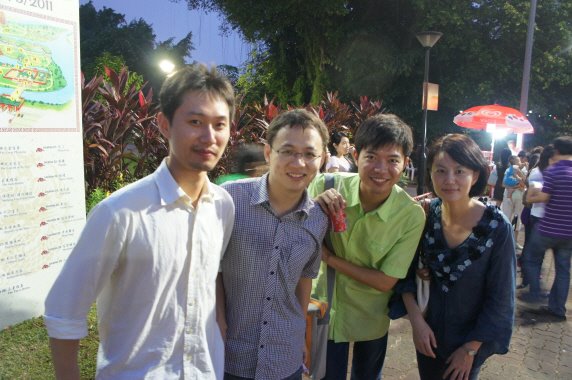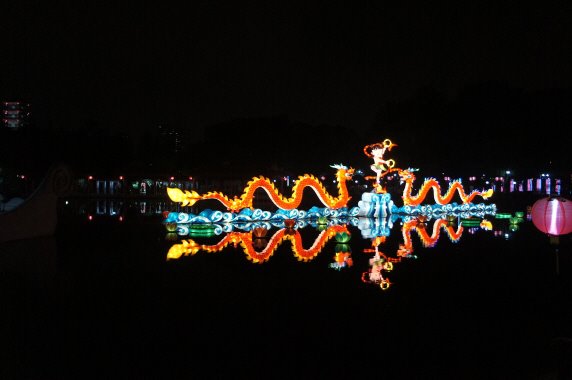by Kabeer Chaudhary, Indian, Nanyang MBA Participant, Intake 2011
Diversity is key to create a great and memorable experience and we are fortunate that The NANYANG MBA fosters this and strive to have such for its students – we have 18 nationalities in our cohort! This diversity in nationalities gives us the opportunity to learn about other people’s culture without having to go that far. And we did – right here in Singapore!
The 2011 Student Executive Committee (Ex-Co) kick-started this year’s events for current students with the celebration of the ‘Mooncake Festival’ in September, also known as the ‘Mid-Autumn’ or ‘Moon Festival’ at the Chinese Gardens. The Chinese Gardens, also known as Jurong Gardens, is one of Singapore’s nature parks and is built over 8 hectares in 1975 under the guidance of a well-known architect from Taiwan. Twenty (20) of us, current MBA students, with our families and friends, walked through the gardens and were greeted by northern Chinese imperial style of architecture and landscaping. The place awed us with its colorful lanterns tied to ancient legends dotting the lake and the grounds and Chinese customs of the festival.
Mooncake or Moon Festival is a popular lunar harvest festival celebrated by the Chinese community all around the world. It falls on the 15th of the 8th month of the lunar calendar and it is one of the most important traditional events for the Chinese and even Vietnamese, just like Christmas and Thanksgiving for Westerners. There are many legends and folklore surrounding the festival from the Moon Goddess of Immortality to the overthrowing of Mongol Rule and to the Vietnamese legend of a wife who accidentally desecrated a sacred banyan tree and was transported to the heavens by the tree for doing so (the Vietnamese light lanterns to show her way down to earth)*. But it is also a favorable time to have a get together and enjoy one another’s company, eating mooncakes under a full moon (for us, we did at the Chinese Garden!). Of course, apart from the delicious mooncakes some of us brought, we were also delighted by mooncakes shared by gracious celebrants who were there to enjoy and celebrate the festivities.
Our Chinese classmates were excited and eager to share with us their culture specially that surround these festivities. Each of us was ‘welcomed’ with a traditional mooncake and our Chinese friends helped to differentiate between flavors such like walnut, lotus, pumpkin and red beans. , Dominic, our Swiss classmate, had a mooncake with a nut filling, and commented, “It was my first time at a Mooncake Festival. I’ve heard a lot about the famous mooncakes and I was excited to finally try them. After trying about every possible mooncake flavor, I can say that my favorite is the one with the nut filling.”

Our night started with a walk around the serene and tranquil garden watching majestic pagodas, statues, bonsai gardens and huge colorful lanterns leading to the holy ‘Wishing Tree’ where visitors can tie golden coins on red ribbons on the branches of the tree in the hope that their wish would be granted. Zhou Dan, one of our classmates from Zhu Hai, China, took all the students around the decorated lanterns and explained how each of the lantern decorations had a legend behind them: the twelve Chinese Zodiacs, the three deities of Good Fortune, Prosperity and Longevity and then the huge lantern of the Legend of Ne-Zha lying beautifully spread across the pond.

After a walk around the garden, the group made its way to the stage area to watch performances made up of magic tricks, dances and a thrilling face mask changing dance. Called Bian Lian, this ancient Chinese dramatic art have its performers wear brightly colored costumes and vividly colored masks which they changed in a fraction of a second right in front of your eyes. This was followed by an extravagant display of fireworks at the pond area ending a fun-filled evening learning about some Chinese traditions.
Everyone had great time learning about Chinese traditions, especially our classmates from Europe. As our Italian classmate Giuseppe, put it – “Having the chance to experience the mooncake festival with my Chinese friends has been very fascinating for me. They helped me to better understand their extraordinary culture. Walking with them across the Chinese Garden give me a true insight of what this festival means to them.”

Dominic, like the rest of our peers, also enjoyed learning about the legends behind the mooncake festival, “Apart from eating mooncakes, I enjoyed learning about the legends behind the mooncake festival, and experiencing Chinese cultural traditions and performances. It was fun to watch the dragon and lion dances, Chinese instrumentalist, and the firework shows. I likened this festival to what we also have in Switzerland which is the Swiss Fasnacht, the largest and most famous festival, which is kind of a carnival. The festival is initiated at 4am when carnival participants walk through the dark streets with lanterns, costumes, and typically big-nosed masks, accompanied by drummers. All in all, the mooncake festival was a nice experience and an interesting change from my own festivals. The colorful lit up lanterns made our walk through Chinese garden really pleasant.
*Sources: Wikipedia